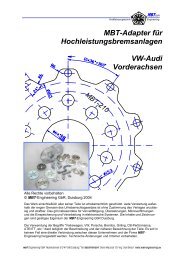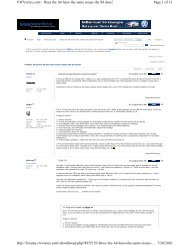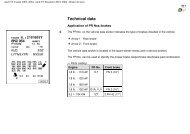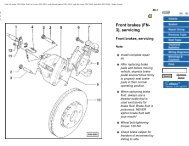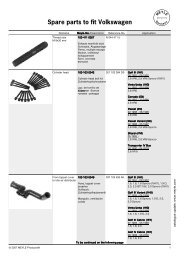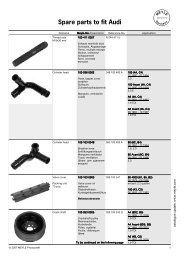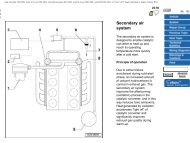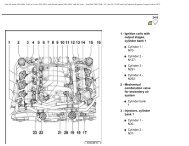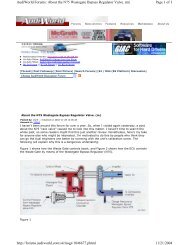VW MKII A2 MK2 Golf Jetta Fox Service Manual - VAGLinks.com
VW MKII A2 MK2 Golf Jetta Fox Service Manual - VAGLinks.com
VW MKII A2 MK2 Golf Jetta Fox Service Manual - VAGLinks.com
You also want an ePaper? Increase the reach of your titles
YUMPU automatically turns print PDFs into web optimized ePapers that Google loves.
5D•2 Starting and charging systems<br />
1 General information and<br />
precautions<br />
General information<br />
The starting and charging system is of a 12<br />
volt negative earth type. The battery is<br />
charged by a belt-driven alternator which<br />
incorporates a voltage regulator. The starter<br />
motor is of pre-engaged type, incorporating a<br />
solenoid which moves the drive pinion into<br />
engagement with the flywheel/driveplate ring<br />
gear before the motor is energised.<br />
An automatic stop-start system is fitted as<br />
optional equipment to some models and is a<br />
fuel economy device. Activated by a control<br />
switch, the system automatically switches off<br />
the engine when the vehicle is stationary<br />
during traffic delays.<br />
The system is switched on and off by<br />
means of a switch on the dash insert between<br />
the instrument panel and the heater/fresh air<br />
control panel. A warning light in the switch<br />
advises when the system is switched on.<br />
The system should only be used when the<br />
vehicle has reached its normal operating<br />
temperature. When activated, the system will<br />
automatically stop the engine when the<br />
vehicle speed drops below 3.1 mph (5 kph)<br />
and has run at its normal idle speed for a<br />
period of at least 2 seconds. In addition the<br />
vehicle must previously have been driven at a<br />
speed in excess of 3.1 mph (5 kph).<br />
When traffic conditions permit, the engine<br />
can be restarted by depressing the clutch<br />
pedal and moving the gear lever fully to the<br />
left in neutral. Once the engine has restarted,<br />
gear engagement can be made in the normal<br />
manner. If for any reason the engine stalls or<br />
stops after restarting, the restart procedure<br />
should be repeated but the gear lever must be<br />
moved back into neutral within 6 seconds.<br />
Precautions<br />
It is necessary to take extra care when<br />
working on the electrical system to avoid<br />
damage to semi-conductor devices (diodes<br />
and transistors) and to avoid the risk of<br />
personal injury. In addition to the precautions<br />
given in the “Safety first!” Section at the<br />
beginning of this <strong>Manual</strong>, take note of the<br />
following:<br />
a) Before disconnecting any wiring or<br />
removing <strong>com</strong>ponents, always ensure that<br />
the ignition is switched off.<br />
b) Disconnect the battery leads before using<br />
a mains charger.<br />
c) Do not reverse the battery connections.<br />
Components such as the alternator or any<br />
other having semi-conductor circuitry<br />
could be irreparably damaged.<br />
d) If the engine is being started using jump<br />
leads and a slave battery, connect the<br />
batteries positive to positive and negative<br />
to negative. This also applies when<br />
connecting a battery charger.<br />
e) Never disconnect the battery terminals or<br />
alternator multi-plug connector when the<br />
engine is running.<br />
f) The battery leads and alternator multiplug<br />
must be disconnected before<br />
carrying out any electric welding on the<br />
vehicle.<br />
g) Never use an ohmmeter of the type<br />
incorporating a hand cranked generator<br />
for circuit or continuity testing.<br />
h) When carrying out welding operations on<br />
the vehicle using electric welding<br />
equipment, disconnect the battery and<br />
alternator.<br />
The following precautions should be taken<br />
when using the automatic stop-start system:<br />
a) Do not use the system when the engine<br />
temperature is below 55°C or when the<br />
ambient temperature is very low as the<br />
engine will take longer to warm up<br />
b) Do not allow the vehicle to roll when the<br />
engine is switched off, check that the<br />
handbrake is fully applied<br />
c) During extended delays, switch the<br />
engine off in the normal manner with the<br />
ignition key as electrical accessories will<br />
otherwise be left on and the battery run<br />
down<br />
d) If leaving the vehicle for any length of<br />
time, switch off the system and always<br />
take the ignition key with you<br />
2 Battery - maintenance<br />
Refer to “Weekly Checks”.<br />
3 Battery - charging<br />
1<br />
1<br />
Warning: The battery will be<br />
emitting significant quantities of<br />
(highly-inflammable) hydrogen<br />
gas during charging and for<br />
approximately 15 minutes afterwards. Do<br />
not allow sparks or naked flames near the<br />
battery or it may explode.<br />
Caution: Specially rapid “boost” charges<br />
which are claimed to restore the power of<br />
a battery in 1 to 2 hours are not<br />
re<strong>com</strong>mended as they can cause serious<br />
damage to the battery plates through<br />
overheating<br />
Caution: If the battery is being charged<br />
from an external power source whilst the<br />
battery is fitted in the vehicle, both battery<br />
leads must be disconnected to prevent<br />
damage to the electrical circuits.<br />
1 In winter when heavy demand is placed on<br />
the battery (starting from cold and using more<br />
electrical equipment), it is a good idea<br />
occasionally to have the battery fully charged<br />
from an external source. The charge rate will<br />
1081 <strong>VW</strong> <strong>Golf</strong> & <strong>Jetta</strong><br />
depend on battery type. For most owners<br />
however, the best method will be to use a<br />
trickle-charger overnight, charging at a rate of<br />
1.5 amps.<br />
2 Rapid `boost’ charges which are claimed to<br />
restore the power of the battery in 1 to 2 hours<br />
are not re<strong>com</strong>mended, as they can cause<br />
serious damage to the battery plates through<br />
overheating and may cause a sealed battery<br />
to explode.<br />
3 Ideally, the battery should be removed from<br />
the vehicle before charging and moved to a<br />
well-ventilated area.<br />
4 Continue to charge the battery until all cells<br />
are gassing vigorously and no further rise in<br />
specific gravity or increase in no-load voltage<br />
is noted over a four-hour period. When<br />
charging is <strong>com</strong>plete, turn the charger off<br />
before disconnecting its leads from the<br />
battery.<br />
4 Battery - removal and refitting<br />
1<br />
Caution: When reconnecting the battery,<br />
always connect the positive lead first and<br />
the negative lead last.<br />
Note: If renewing the battery, a centralised<br />
ventilation type battery is re<strong>com</strong>mended<br />
rather than one with ventilation plugs. If a<br />
battery with ventilated plugs is fitted, it will be<br />
necessary to fit a protective cover over the<br />
battery to prevent water spray entering and<br />
causing it to be over-filled, which would cause<br />
the acid level within the battery to overflow<br />
and damage surrounding <strong>com</strong>ponents<br />
Removal<br />
1 The battery is located in the engine<br />
<strong>com</strong>partment on the left-hand side.<br />
2 Loosen the battery terminal clamp nuts and<br />
disconnect the negative lead followed by the<br />
positive lead (see illustration).<br />
3 Unscrew the bolt and remove the battery<br />
retaining clamp (see illustration).<br />
4 Lift the battery from its platform whilst<br />
taking care not to spill any electrolyte on the<br />
bodywork.<br />
4.2 Battery positive terminal connection



